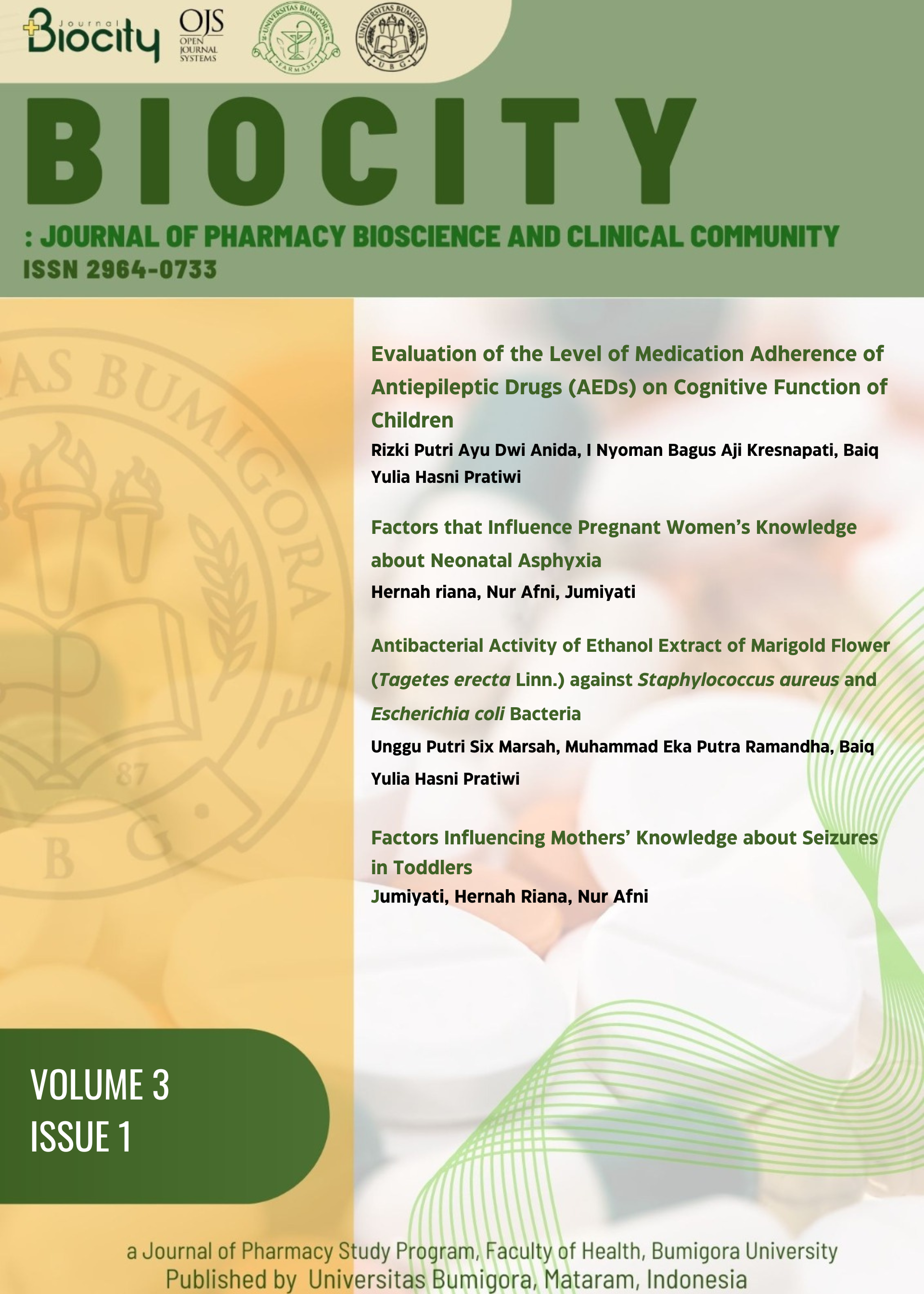Faktor-Faktor yang Mempengaruhi Pengetahuan Ibu Hamil tentang Asfiksia Neonatorum
DOI:
https://doi.org/10.30812/biocity.v3i1.4558Kata Kunci:
Age, Education, Neonatal asphyxia, Parity, Pregnant womenAbstrak
Neonatal asphyxia is one of the causes of lack of blood flow or gas exchange to or from the fetus in the period immediately before, during, or after the birth process. According to data from the World Health Organization (WHO), 28 billion babies die after the first 28 days because that time is the adaptation period experienced by babies to determine whether they can survive or not. One of the leading causes is asphyxia, which results in 11% of infant deaths. This research aims to determine the factors that influence pregnant women's knowledge about neonatal asphyxia based on age, parity, and maternal education. This research is an analytical survey with a cross-sectional approach in the Kolakaasi Community Health Center work area. The research sample used was 75 respondents with a questionnaire instrument. The research results show that the statistical test results using the chi-square test, the probability is smaller α (p < α) (0.001 <0.05). This result statistically shows that there is a significant relationship between age, parity, and maternal education on knowledge about neonatal asphyxia. Therefore, it can be concluded that age, parity, and maternal education influence maternal knowledge regarding neonatal asphyxia.
Referensi
Afriani, R., & Sulistyoningtyas, S. (2023). Determinan Kejadian Asfiksia Neonatorum Di Rs Pku Muhammadiyah Gamping Tahun 2021. Journal of Midwifery and Health Research, 1(2), 1–8. https://doi.org/10.36743/jmhr.v1i1.478
Alfina, Haniarti, Anggraeny, R., Henni, K., Majid, M., & Supardi. (2023). Determinan Kejadian Asfiksia Neonatorum pada Bayi Aterm di RSUD Andi Makkasau Kota Parepare. Jurnal Ilmiah Manusia Dan Kesehatan, 6(2), 336–347. DOI: https://doi.org/10.31850/makes.v6i2.2159
Anisa, D. R., & Harahap, D. A. (2024). Relationship Between Birth Weight And Incidence Of Neonatal Asphyxia At Bangkinang Hospital. 3(April), Evidence Midwifery Journal, Vol. 3 No. 3 (2024): JULI 2024 , https://doi.org/10.31004/emj.v3i3.27407
Batubara, A. R., & Fauziah, N. (2020). Faktor Yang Mempengaruhi Kejadian Asfiksia Neonatorum Di RSU Sakinah Lholsemawe. Jurnal of Healthcare Technology and Medicine, 6(1),411–423. https://jurnal.uui.ac.id/index.php/JHTM/article/view/707/322
Dinas Kesehatan Kolaka. 2022. Profil Kesehatan Provinsi Sulawesi Tenggara Tahun 2022
Fidayanti, N., Iriyani, E., & Ashari, M. A. (2023). Faktor-Faktor Yang Mempengaruhi Kejadian Asfiksia Pada Bayi Baru Lahir Di Rsu Pku Muhammadiyah Bantul Yogyakarta Tahun 2022. Cerdika: Jurnal Ilmiah Indonesia, 3(11), 1086–1096. https://doi.org/10.59141/cerdika.v3i11.706
Fristika, Y. O. (2021). Hubungan Lama Ketuban Pecah Dini , Umur ibu , Paritas dan Jenis Persalinan terhadap Nilai APGAR. Jurnal Kebidanan Jurnal Medical Science Ilmu Kesehatan Akademi Kebidanan Budi Mulia Palembang, 11(1), 99–111. https://journal.budimulia.ac.id/index.php/kebidanan/article/view/256
Gillam-Krakauer, M., Gowen Jr, C.W. Birth Asphyxia. Treasure Island (FL): Stat Pearls Publishing. 2020
Jumiarni Ilyas, Sri, M., & Nurlina, S. (2016). Asuhan Keperawatan Perinatal. EGC.
Khoiriah, Annisa, and Tiara Pratiwi. 2021. “Faktor-Faktor Yang Berpengaruh Terhadap Kejadian Asfiksia Pada Bayi Baru Lahir.” Jurnal ’Aisyiyah Medika 4 (1): 56–62. https://doi.org/10.36729/jam.v4i0.588.
Lydia Lestari, D. (2024). Asfiksia Neonatorum. Scientific Journal, 3(1), 08–15. https://doi.org/10.56260/sciena.v3i1.124
Mahyar, Budi, S. M., & Apriliyani Ita. (2023). Faktor - Faktor yang Berhubungan dengan Nilai APGAR Skor Neonatus Pada Ibu Sectio Caesarea dengan Anestesi Spinal di Rumah Sakit Umumm Daerah Pidie Jaya Aceh. Jurnal Kesehatan, Kebidanan, Dan Keperawatan, 16(2), 130–137. https://doi.org/10.35960/vm.v16i2.918
Nursalam. (2021). Konsep dan Penerapan Metodologi Penelitian Ilmu Keperawatan : Pedoman Skripsi, Tesis, dan Instrumen Penelitian Keperawatan. Salemba Medika.
Pratama Kurnia Mustikasari Rini, & Handayani Mustika Ayu. (2022). Faktor Risiko Asfiksia Neonatorum Risk Factors of Asphyxia Neonatorum. Jurnal Ilmu Kebidanan, 2, 55–63. DOI: https://doi.org/10.54444/jik.v12i2.111
Prawirohardjo Sarwono. (2020). Ilmu Kebidanan (P. B. P. S. Prawirohardjo (ed.)).
Primihastuti, Dkk. (2021). Masalah Dalam Kehamilan, Yogyakarta, Nuha medika
RI, K. K. (2023). Profil Kesehatan Indonesia 2022. Kementerian Kesehatan RI.
Rufaindah, Re., Muzayyana, Sulistyawati, E., Hasnita, Y., Sari, N. A. K. E., Mustikawati, N., Patemah, Mariyam, & Meiriza, W. (2022). Tatalaksana Bayi Baru Lahir (Made Martini (ed.)). Media Sains Indonesia.
Shanun Shari Sakunti, Rini Fitriani, Syatirah Jalaluddin, & Andi Tihardimanto. (2024). Analysis of Risk Factors of Neonatal Asphyxia in Labuang Baji Hospital, Makassar, 2021. Alami Journal (Alauddin Islamic Medical) Journal, 8(2), 63-73. https://doi.org/10.24252/alami.v8i2.36692
Tandiallo Devianti dkk, (2023) Hubungan Paritas Dengan Kejadian Asfiksia Neonatorum Di RSUD Batara Guru Belopa, Journal of Borneo Holistic Health, Volume, 6 No 2. Desember 2023 hal 139-145, https://doi.org/10.35334/borticalth.v6i2.3667
Trismayanti Putu, dkk (2023). Hubungan Usia Ibu, Usia Kehamilan Dan Anemia Selama Kehamilan Dengan Kejadian Asfiksia Neonatorum. Jurnal Of Maternity And Neonatal, Vol.12 No. 1A (2024), https://doi.org/10.30606/jmn.v12i1A.2669
WU Ekasari, DS Wati, ER Saputri,. (2023). Analisis Faktor Yang Mempengauhi Asfiksia Pada Bayi Baru Lahir Aterm. Indonesia Jurnal Kebidanan, 22-24.https://doi.org/10.26751/ijb.v8i1.2475
Unduhan
Diterbitkan
Terbitan
Bagian
Lisensi
Hak Cipta (c) 2024 Hernah Riana, Nur Afni, Jumiyati Jumiyati

Artikel ini berlisensiCreative Commons Attribution-ShareAlike 4.0 International License.

















